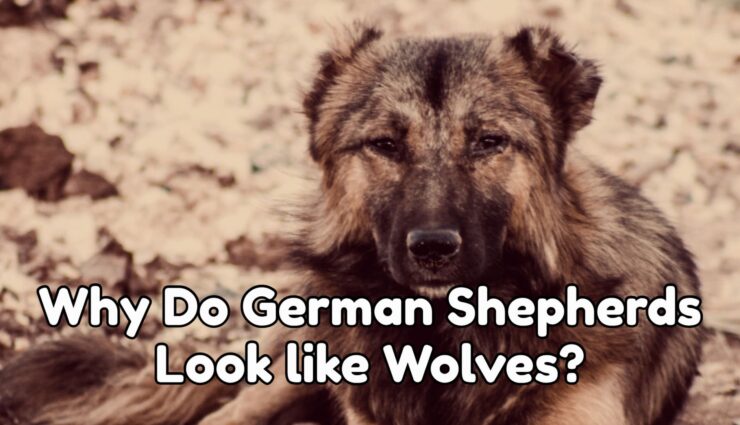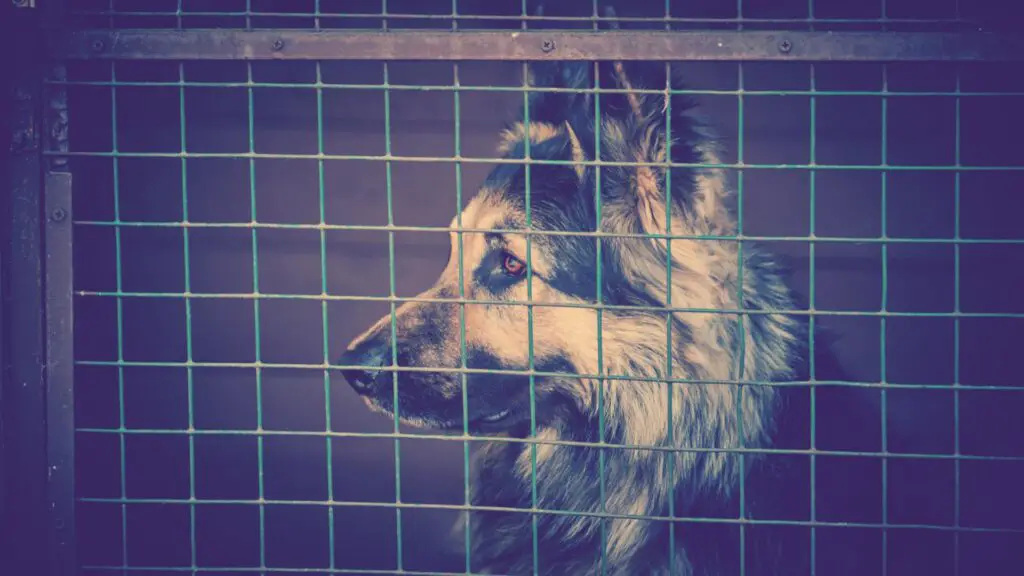More often, some dog breeds, particularly the German Shepherds, have a more wolf-like resemblance than other dog -breeds.
Based on their physical appearances, German shepherds look like wolves.
As the owner or future owner of this breed, you probably must wonder whether there is a relationship between German Shepherds and wolves.
An individual that has never set his/her eyes on a German shepherd may for the first time think “wow! That looks just like a domesticated wolf.” When it comes to facial appearance, coloring, and stance, the German shepherd looks like a wolf.
Additionally, a German shepherd in simple terms is a wolf-dog, a dog whose reproduction is after mating between a dog and a wolf. A detailed analysis of the bloodline, biology, and history can help us properly understand the relationship responsible for the resemblance between the German shepherds and wolves.
History of the German Shepherd Dog Breeds
Dogs share a common ancestral background with gray wolves, hence why you will often find most people say German shepherd look like wolves. In the 1800s, the most common dogs among shepherds included a pack of herding dogs known as “continental shepherd dogs.” This group composed of the Belgian Shepherd, German shepherd, and Dutch Shepherd dog breeds.
By then, the German shepherd dog (GSD) was still not accepted as an official herding breed.
Once identified as Alsatian Wolf Dog, the German Shepherds are not part of wolves but are part of a large biological family known as Canidae. This family group comprises wolves, foxes, and dingoes.
Historically, the first German shepherd dog breed was developed in 1899 by Max von Stephanitz. Captain Stephanitz got an influence after attending a dog exhibition in Germany. It is at this place that Max von Stephanitz came across a dog (Hektor Linksrhein). And this dog had wolf genes in its system.
Furthermore, he had a belief that dog should work and help man. And such a drive saw him purchase this dog.
Max von Stephanitz also wanted to give rise to a new and standard dog breed, particularly for herding. It is after he noted that there were a variety of shepherd dogs in the native country.
Impressed with the dog’s intelligence, strength, physical appearance and obedience, Max von Stephanitz purchased the dog and renamed him Horand von Grafrath.
Horand von Grafrath is the ‘father of German shepherds.’
Additionally, upon purchasing the dog breed, Von Stephanitz instituted the Society for German Shepherd Dogs. With Horand von Grafrath being the first GSD recorded in the records of the society breed.
Later, Horand bred with dogs from other breeding societies, which demonstrated various unique characteristics, similar to Horand’s. The use of wolf dogs in the breeding process saw the rise of a generation of wolf-resembling dog breeds (the GSDs).
Von Stephanitz started including such breeds as Thuringian cross show dog, whose appearance resembles the gray wolf. These gray wolves exhibited such features as erect ears, fuzzy gray hair coupled up with coiled tails.
Genes of other gray wolves’ family Like Thuringian cause most current GSDs to have a high percentage of wolf-like traits.
However, while Von Max was impressed by Horand’s appearance, he was not utterly contented that this dog was easy to train and expressed high desires to play. He noted that his dog’s had lots of unharnessed energy.
Max’s desire for a work-based dog breed fueled him to look for other non-standardized shepherd dogs in the local German towns for breeding.
The Thuringian dogs have high energy, wolf-gray color, and a history of being a show dog.
The Wurttemberg Sheep Dog, on the other hand, has the genetic characteristics of a large dog with heavy bones, a thicker working type body and the working structure (thicker head, chest and paws) and working stamina.
The Wurttemberg Sheep dogs were intelligent, trainable, and recognized to be highly respected, especially by their effectiveness in protecting flocks.
The Swabian Service Dog was the most adaptable and largest of the three breeds. The Swabian service dogs had very leveled temperaments, exceptional working ability and incredible courage in intimidating circumstances.
Also read: pros and cons of owning a GSD.
The Breeding Practices of German shepherd Dog
After Von Stephanitz created the first German shepherd dogs in the late 1890s, he continued to breed, refine and promote the GSD for three more decades.
The breeding process gained popularity across the United States and the UK in the early 20th century, partly following the starring of a dog like Rin-Tin-Tin and partly from returning soldiers of the World War I who praised the breed’s characteristics.
The German Shepherd Dog has always maintained its traits as a wolf dog and wolf-like appearances.
More interestingly, there has been a sudden rising interest in wolf-dogs hybrids over the last one decade.
The German shepherd dogs have become more popular due to their partial appearance in movies, documentaries, and TV shows such as Game of Thrones.
General Appearance of Modern German shepherd Dogs
The German shepherd dog is a well-muscled, strong, agile, ever-ready, and healthy dog. The GSD also has a balance, with a harmonious development of the forelegs and hind legs.
The German shepherd dog is longer than it is height-Also, it has a deep body, and presenting an outline of a smoothly curved than an angular body. Consequently, this dog appears massive, giving the impression of muscular fitness and nimbleness at both rest and in motion.
Besides, an ideal German shepherd dog has a look of quality and decency. Secondary sex features of GSD are strongly marked, and every animal gives a definite impression of masculinity or femininity, based on its sex.
Key: Often male German shepherds are moving masculine than female German shepherds.
And such a characteristic is distinctive in the Canidae family.
Plus: How to groom a German Shepherd?
Comparing German Shepherds and Wolves
Some characteristics that compare a German shepherd to a wolf include; body size bite force and many more.
Vital Statistics (Body Size, Weight, Biting Force and Speed)
Statistically, an adult male wolf is between 66 and 81 cm tall, whereas a fully grown male German shepherd dog has a height ranging from 60 to 65 cm.
In terms of weight, a wolf is heavier than a German shepherd dog. On average, a fully grown male wolf weighs from 30 to 80 kg. Whereas, an ideal male German shepherd weighs 22 to 40 kg.
Bite Force
The German Shepherd Dog has a bite force of 238 pounds. Whereas, wolves have stronger jaws with a biting capacity of nearly 400 pounds of pressure.
Speed
A German shepherd has a speed of 63 km/h, 12km/h less than that a wolf that can run at 75 km/h.
Birth and Maturity
German Shepherd’s reproduction varies from that of wolves.
While wolves have a single breeding season per year, you find that a tamed dog such as the German shepherd can breed up to two times a year.
Moreover, wolves demonstrate a faster maturity rate than the German Shepherd Dogs. Its maturity bases on the fact that wolves are more adapted to a life of individuality and self-reliance than domesticated dogs. You find that majority of wild animals start to prepare themselves to be independent at an earlier stage of development, for them to survive the wildlife.
On the contrary, domestic dogs such as the GSD, which are more dependent on their human companions, have a slower maturing rate.
Important read: German Shepherd life expectancy.
Physical Appearance
Wolves have yellow eyes, whereas German shepherd dogs typically have dark brown eyes. Their coats differ a lot from wolves, since the wolves only have camouflage colors that protect them from antagonistic animals in the wild.
On the contrary, the GSD has a double coat of medium length, with the upper coat being denser, with straight hair and lies close to the body.
The head and legs of the German shepherd have short hair. Consequently, the neck has long and thick hair, similar to a wolf.
While the forelegs and hind legs of a GSD are longer in proportion to its body, they are shorter than wolves.
However, wolves and the German shepherd dogs have narrow and keel-shaped chests (resembling the front of a boat) with their elbows tucking closely just under the rib cage, although wolves’ tails are straighter and have large paws than the German shepherd’s.
Behavioral Characteristics
You may find that wolves are shy and avoid direct eye contact, but demonstrate high intelligence than German Shepherd Dogs. German shepherd easily socializes with people and other tamed animals, whereas wolves are very antisocial.
The social learning process of wolves revolves on the relations and practices shared among their packs, unlike German shepherd dogs, who are social with humans.
Due to their dependency on human companions and longing for human attention and affection, shepherd dogs cannot survive independently or in parks. On the other hand, wolves observe a strict pack hierarchy, and therefore they cannot relate to humans or other wild animals.
Quick table comparing the German shepherd and the wolf –
| Character | German Shepherd | Wolf |
| Family | Canidae | Canidae |
| Length | 60-65 cm | 66-81 cm |
| Weight | 22-40 kgs | 30-80 kgs |
| Eyes | Dark brown | yellow |
| Bite force | 238 KJ | 400kj |
| speed | 63 Km/Hr. | 75 Km/Hr. |
| Temperament | Intelligent, loyal, | Shy, aggressive |
Health Issues/ Problems
A German shepherd has a lifespan of approximately 15 years.
However, the German shepherd can still be vulnerable to health issues despite the breed being a combination of two healthy breed parents. Your German shepherd can be susceptible to genetic illnesses such as hip dysplasia, elbow dysplasia, and bloating.
Are There Changes In The Breeding Process?
Several debates exist amongst breeders and German shepherd dog owners on whether the GSD breed has changed the first breeds of late 19th century.
You may be wondering whether your dog shares some genetic features or resemblance to wolves. Another common question is whether or not contemporary dog breeders have included some wolf genetics in the breeding process.
However, there is no drafted evidence to authenticate this theory – either on paper or genetic tests.
As a German shepherd dog owner, you may still be asking yourself how close is your dog related to the wild gray wolf.
Despite the thought that ‘the father of all German shepherd dogs’ (Horand) was partially a wolf and that Captain Stephanitz included wolf-dogs in the subsequent breeding- debates still exist of how much of the wolves genes are present in the German Shepherd breeds.
Frequently Asked Questions
A German Shepherd Dog/Wolf Fight, Who Will Win?
You might be asking yourself how a fight between a wolf and GSD can be like, and who will emerge the winner?
The wolf is naturally trained in the wild and possesses high intelligence. And with that, it demonstrates a high survival rate and thrives in an adverse wild ecosystem.
On the other hand, a German shepherd is a dog that has been trained by people to perform different tasks. They are also intelligent and strong, just like wolves.
However, it is generally difficult to judge who will win if by chance the two met for a battle. Nevertheless, wolves have strong stamina than German Shepherd Dogs and demonstrate a wild-based instinct.
One advantage of a German shepherd is that it can endure a lot of physical pain, suggesting that it can survive wolf attacks. However, unlike the German shepherd trained to attack based on circumstances solely, wolves attack in packs.
Can a German shepherd and a Wolf Mate?
Yes, a German shepherd and a wolf can mate. And the resultant breed will be known as wolf-shepherd or wolf-dog.
However, most states don’t approve such breeding standards and practices.
The Exit
As from the above article, it’s evident that a German shepherd looks like a wolf. And such resemblance is attributed to the first parents of the German shepherd we have at present.
What’s your thought about this controversial topic? Drop it in the comment box.





